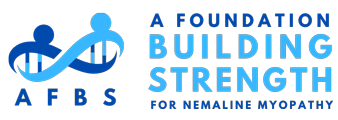Nemaline Myopathy (NM) is a disorder that primarily affects skeletal muscles, which are muscles that the body uses for movement, and can also affect other organs and body systems. Muscle weakness (myopathy) is typically most severe in the muscles of the face, neck, body core, and other muscles close to the center of the body (proximal muscles), such as those of the upper arms and legs. This weakness can usually improve to some degree with physical therapy, but may worsen due to growth spurts, injuries or surgeries, poor nutritional status, gaining too much weight, mental health problems, sedentary lifestyles, a medication or therapy, another medical condition, becoming pregnant, and/or the aging process in adulthood.
Some people with NM are able to achieve walking for at least part of their lives, although many affected children begin walking later than usual, while others may never stand or walk unassisted. Some people may require a wheelchair only some of the time, such as for long distance walking or when outside of the house.
Affected individuals may have eating and swallowing difficulties, speech impairment, jaw anomalies, eustachian tube malfunctioning, digestive problems, bone deformities such as abnormal curvature of the spine (scoliosis), and/or joint deformities (contractures).
In many cases, the breathing muscles are weak, and life-threatening breathing difficulties can occur. Many will need bi-level breathing assistance provided via mechanical ventilation, which can be non-invasively delivered using a mask interface that covers the nose (nasal), nose and mouth (oronasal), or whole face (full facial). Sometimes when the bulbar muscles are too weak and non-invasive ventilation fails to provide sufficient support even under optimal machine settings and optimal care, some individuals will transition to invasive mechanical ventilation via tracheostomy. Some people with NM, from all age groups and all levels of severity, will be lost to sudden death related to the disorder.
NM varies greatly in severity from one person to another, from mild weakness to no muscle contraction ability. NM does not affect brain development or cognitive function, however.
Nemaline Myopathy has an estimated incidence of 1 in 50,000 individuals.
Nemaline Myopathy is usually inherited in an autosomal recessive pattern, which means both copies of the gene in each cell have mutations. The parents of an individual with an autosomal recessive condition each carry one copy of the mutated gene, but they typically do not show signs and symptoms of the condition.
Less often, this condition is inherited in an autosomal dominant pattern, which means one copy of the altered gene in each cell is sufficient to cause the disorder. Most cases result from new mutations in the gene and occur in people with no history of the disorder in their family.
Mutations in one of many genes can cause nemaline myopathy. These genes provide instructions for producing proteins that play important roles in skeletal muscles. Within skeletal muscle cells, these proteins are found in structures called sarcomeres. Sarcomeres are necessary for muscles to tense (contract). Many of the proteins associated with nemaline myopathy interact within the sarcomere to facilitate muscle contraction. When the skeletal muscle cells of people with nemaline myopathy are stained and viewed under a microscope, these cells usually appear abnormal. These abnormal muscle cells contain rod-like structures called nemaline bodies.
Nemaline Myopathy (NM) is a clinically and genetically heterogeneous disease, with a wide range of clinical phenotypes and an association with mutations in at least 12 known genes (ACTA1, NEB, TPM3, TPM2, TNNT1, TNNT3, CFL2, KBTBD13, KLHL40, KLHL41, LMOD3, MYPN, MYO18B).
Most cases of NM with a known genetic cause result from mutations in one of two genes, NEB or ACTA1. NEB gene mutations account for about 50 percent of all cases of NM and ACTA1 gene mutations account for 15 to 25 percent of all cases.
How Is Nemaline Myopathy Diagnosed?
Nemaline Myopathy is diagnosed through genetic testing. If you have not pursued genetic confirmation or have received non-specific genetic results, please consider the following:
Detect Muscular Dystrophy is a free genetic testing resource for those living in the US suspected of having a a form of NM, who do not yet have genetic confirmation of their subtype. We encourage the NM community to take advantage of this free program while it lasts. No referral is needed. No health insurance is required. The blood draw is done locally. Findings are reported to your physician who then orders clinical confirmation, with results reported to you through your physician. If you are interested in genetic testing to confirm the type of Nemaline Myopathy that you or your child has, and you would like personalized guidance from the AFBS team, please complete this short form.

